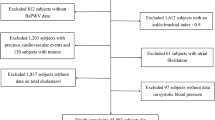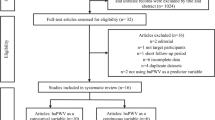Abstract
Angiotensin II plays a key role in the development of vascular disease. We examined the long-term effects of selective angiotensin II receptor (ATR) blockade with valsartan on arterial wall stiffness. Brachial to ankle pulse wave velocity (baPWV) was measured in 28 women and 25 men with hypertension (mean age: 62±2 years). The measurements were repeated after 24 weeks of treatment with valsartan, 40 to 160 mg/day, with (n=10) or without (n=36) concomitant statin therapy. By multiple regression analysis, baseline baPWV was correlated with age (p<0.001), systolic blood pressure (SBP, p<0.0001), body mass index (p=0.018), and pulse pressure (p=0.005), but not with total cholesterol (p=0.446). Valsartan lowered mean SBP and diastolic blood pressure (DBP) from 155±3 to 140±3 mmHg and from 90±2 to 82±2 mmHg, respectively, and mean baPWV from 1,853±49 to 1,682±52 cm/s. Lowering of baPWV was not influenced by statin therapy. An overlap analysis was performed to separate the effect of angiotensin II receptor blockade from that of blood pressure (BP) lowering. The decrease in the baPWV value of 1,794±46 cm/s before valsartan (n=39) vs. 1,663±45 cm/s during valsartan (p=0.048, n=31) at a similar mean SBP level (149±2 vs. 146±3 mmHg, p=0.304) confirmed that ATR blockade had a beneficial effect independent of BP lowering. SBP strongly influences baPWV. However, the decrease in baPWV with valsartan was independent of BP lowering. Statins had no synergistic effect on baPWV. Lowering of baPWV may account for the therapeutic benefit conferred by valsartan independent of its BP-lowering effect.
Similar content being viewed by others
Article PDF
References
Dzau VJ : Theodore Cooper Lecture: tissue angiotensin and pathobiology of vascular disease: a unifying hypothesis. Hypertension 2001; 37: 1047–1052.
Griendling KK, Minieri CA, Ollerenshaw JD, Alexander RW : Angiotensin II stimulates NADH and NADPH oxidase activity in cultured vascular smooth muscle cells. Circ Res 1994; 74: 1141–1148.
Itoh H, Mukoyama M, Pratt RE, Gibbons GH, Dzau VJ : Multiple autocrine growth factors modulate vascular smooth muscle cell growth response to angiotensin II: J Clin Invest 1993; 91: 2268–2274.
Pollman MJ, Yamada T, Horiuchi M, Gibbons GH : Vasoactive substances regulate vascular smooth muscle cell apoptosis. Countervailing influences of nitric oxide and angiotensin II. Circ Res 1996; 79: 748–756.
Benetos A, Levy BI, Lacolley P, Taillard F, Duriez M, Safar ME : Role of angiotensin II and bradykinin on aortic collagen following converting enzyme inhibition in spontaneously hypertensive rats. Arterioscler Thromb Vasc Biol 1997; 17: 3196–3201.
Hoshino J, Sakamaki T, Nakamura T, et al: Exaggerated vascular response due to endothelial dysfunction and role of the renin-angiotensin system at early stage of renal hypertension in rats. Circ Res 1994; 74: 130–138.
de Gasparo M, Catt KJ, Inagami T, Wright JW, Unger T : International union of pharmacology. XXIII. The angiotensin II receptors. Pharmacol Rev 2000; 52: 415–472.
Blacher J, Asmar R, Djane S, London GM, Safar ME : Aortic pulse wave velocity as a marker of cardiovascular risk in hypertensive patients. Hypertension 1999; 33: 1111–1117.
Laurent S, Boutouyrie P, Asmar R, et al: Aortic stiffness is an independent predictor of all-cause and cardiovascular mortality in hypertensive patients. Hypertension 2001; 37: 1236–1241.
Asmar RG, London GM, O'Rourke ME, Safar ME, REASON Project Coordinators and Investigators : Improvement in blood pressure, arterial stiffness and wave reflections with a very-low-dose perindopril/indapamide combination in hypertensive patient: a comparison with atenolol. Hypertension 2001; 38: 922–926.
Boutouyrie P, Tropeano AI, Asmar R, et al: Aortic stiffness is an independent predictor of primary coronary events in hypertensive patients: a longitudinal study. Hypertension 2002; 39: 10–15.
van Popele NM, Grobbee DE, Bots ML, et al: Association between arterial stiffness and atherosclerosis: the Rotterdam Study. Stroke 2001; 32: 454–460.
Yamashina A, Tomiyama H, Takeda K, et al: Validity, reproducibility, and clinical significance of noninvasive brachial-ankle pulse wave velocity measurement. Hypertens Res 2002; 25: 359–364.
Ichihara A, Hayashi M, Koura Y, Tada Y, Hirota N, Saruta T : Long-term effects of intensive blood-pressure lowering on arterial wall stiffness in hypertensive patients. Am J Hypertens 2003; 16: 959–965.
McDonald DA : Regional pulse-wave velocity in the arterial tree. J Appl Physiol 1968; 24: 73–78.
West of Scotland Coronary Prevention Study Group : Influence of pravastatin and plasma lipids on clinical events in the West of Scotland Coronary Prevention Study (WOSCOPS). Circulation 1998; 97: 1440–1445.
Benetos A, Adamopoulos C, Bureau JM, et al: Determinants of accelerated progression of arterial stiffness in normotensive subjects and in treated hypertensive subjects over a 6-year period. Circulation 2002; 105: 1202–1207.
de las Heras N, Aragoncillo P, Maeso R, et al: AT1 receptor antagonism reduces endothelial dysfunction and intimal thickening in atherosclerotic rabbits. Hypertension 1999; 34: 969–975.
Munakata M, Nagasaki A, Nunokawa T, et al: Effects of valsartan and nifedipine coat-core on systemic arterial stiffness in hypertensive patients. Am J Hypertens 2004; 17: 1050–1055.
Avolio AP, Deng FQ, Li WQ, et al: Effects of aging on arterial distensibility in populations with high and low prevalence of hypertension: comparison between urban and rural communities in China. Circulation 1985; 71: 202–210.
Tomiyama H, Arai T, Koji Y, et al: The age-related increase in arterial stiffness is augmented in phases according to the severity of hypertension. Hypertens Res 2004; 27: 465–470.
Amar J, Ruidavets JB, Chamontin B, Drouet L, Ferrieres J : Arterial stiffness and cardiovascular risk factors in a population-based study. J Hypertens 2001; 19: 381–387.
Moritani T, Crouse SF, Shea CH, Davidson N, Nakamura E : Arterial pulse wave velocity, Fourier pulsatility index, and blood lipid profiles. Med Sci Sports Exerc 1987; 19: 404–409.
Mourad JJ, Pannier B, Blacher J, et al: Creatinine clearance, pulse wave velocity, carotid compliance and essential hypertension. Kidney Int 2001; 59: 1834–1841.
McGrath BP, Liang YL, Kotsopoulos D, Cameron JD : Impact of physical and physiological factors on arterial function. Clin Exp Pharmacol Physiol 2001; 28: 1104–1107.
Lantelme P, Mestre C, Lievre M, Gressard A, Milon H : Heart rate: an important confounder of pulse wave velocity assessment. Hypertension 2002; 39: 1083–1087.
Imanishi R, Seto S, Toda G, et al: High brachial-ankle pulse wave velocity is an independent predictor of the presence of coronary artery disease in men. Hypertens Res 2004; 27: 71–78.
Okamura T, Moriyama Y, Kadowaki T, Kanda H, Ueshima H : Non-invasive measurement of brachial-ankle pulse wave velocity is associated with serum C-reactive protein but not with alpha-tocopherol in Japanese middle-aged male workers. Hypertens Res 2004; 27: 173–180.
Munakata M, Sakuraba J, Tayama J, et al: Higher brachial-ankle pulse wave velocity is associated with more advanced carotid atherosclerosis in end-stage renal disease. Hypertens Res 2005; 28: 9–14.
Mitchell GF, Parise H, Benjamin EJ, et al: Changes in arterial stiffness and wave reflection with advancing age in healthy men and women: the Framingham Heart Study. Hypertension 2004; 43: 1239–1245.
Matsui Y, Kario K, Ishikawa J, Eguchi K, Hoshide S, Shimada K : Reproducibility of arterial stiffness indices (pulse wave velocity and augmentation index) simultaneously assessed by automated pulse wave analysis and their associated risk factors in essential hypertensive patients. Hypertens Res 2004; 27: 851–857.
Ichihara A, Hayashi M, Koura Y, Tada Y, Kaneshiro Y, Saruta T : Long-term effects of statins on arterial pressure and stiffness of hypertensives. J Hum Hypertens 2005; 19: 103–109.
Author information
Authors and Affiliations
Corresponding author
Rights and permissions
About this article
Cite this article
Nakamura, T., Fujii, S., Hoshino, J. et al. Selective Angiotensin Receptor Antagonism with Valsartan Decreases Arterial Stiffness Independently of Blood Pressure Lowering in Hypertensive Patients. Hypertens Res 28, 937–943 (2005). https://doi.org/10.1291/hypres.28.937
Received:
Accepted:
Issue date:
DOI: https://doi.org/10.1291/hypres.28.937
Keywords
This article is cited by
-
Cardiovascular Structural and Functional Parameters in Idiopathic Pulmonary Fibrosis at Disease Diagnosis
High Blood Pressure & Cardiovascular Prevention (2024)
-
Vascular Aging and Disease of the Large Vessels: Role of Inflammation
High Blood Pressure & Cardiovascular Prevention (2019)
-
Pulse pressure is not an independent predictor of outcome in type 2 diabetes patients with chronic kidney disease and anemia—the Trial to Reduce Cardiovascular Events with Aranesp Therapy (TREAT)
Journal of Human Hypertension (2016)
-
Positive effects of antihypertensive treatment on aortic stiffness in the general population
Hypertension Research (2014)
-
Impact of metabolic indices on central artery stiffness: independent association of insulin resistance and glucose with aortic pulse wave velocity
Diabetologia (2010)



